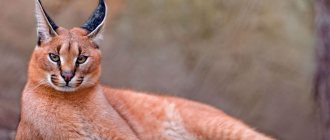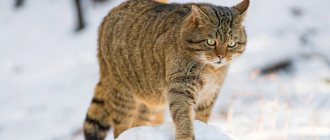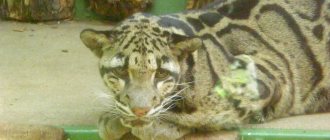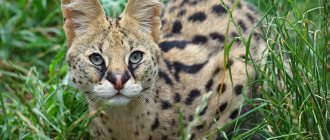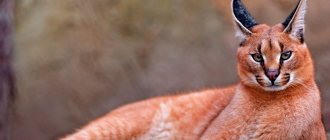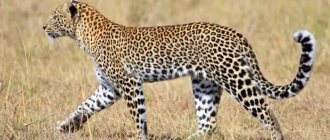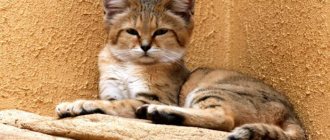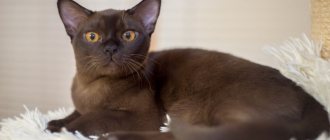External features
The photo of the animal lynx shows an outwardly attractive, fluffy cat, the length of which varies from 80 to 130 centimeters. Height at withers 50-70 centimeters. Basically, the size of a lynx is similar to that of a large dog. An adult lynx weighs from 18 to 35 kilograms. The cat's ears end in long tufts and the tail is short. The lynx's large, high paws, which grow long hair in winter, help them move through the snow without any problems.
Depending on the territory where the lynx lives, its color varies, from red to smoky, with spots on the back, sides and paws. The predator has a unique silky coat. The claws of the lynx, like those of other feline predators, do not leave imprints on the snow.
Zoroastrian horoscope
The period of activity is the cold season, the winter season gives the totem strength, and the inherent coloring of the lynx strengthens its natural strength. The color is gray, which from time immemorial has been associated with the veil that stores ancient knowledge and separates the obvious from the secret. According to the Zoroastrian horoscope, the years of the cycle are: 1929, 1961, 1993, 2025, 2057.
In mythology, the Lynx was credited with the ability to see through walls, predict places with traps, and endowed her with extraordinary courage, so that she could even argue with a bear. The sign of the Lynx follows the Swan and symbolizes foresight, a state of insight and illumination. The main goal in life is to explore the unknown.
Antitotem
The opposite sign is the Mouse. Under the power of the antitotem, they show extreme cowardice. Such people are called “suckers”, they are not respected because they do not have their own point of view and are ready to bend to anyone who is stronger than them. They are very dependent on the assessment and opinions of others, they will do everything not to lose importance in the eyes of other people, but with all their actions they come to the opposite.
They are often the instigators of fights when there is a strong opponent on their side. They add fuel to the fire and try to quickly retreat from the scene, leaving their comrade to take the rap for them. The main features of the Mouse are deceit, slipperiness, extreme forms of hypocrisy and tediousness.
Lynx habitats
The territory where the lynx lives is the north; sometimes it lives even beyond the Arctic Circle. The lynx's favorite habitats are dense forests, although it is found in a variety of places.
Previously, the predator was distributed throughout European territory, but in the 20th century it was exterminated in many countries. At the present time, successful attempts are being made to revive the lynx. In the Russian Federation its numbers are small.
Hunting and diet of lynx
The lynx is an excellent hunter, which is aided by its excellent ability to climb trees. Another factor that helps in hunting is good camouflage. Spots on the fur make the lynx invisible during the day, among the glare of the sun, and help to hide at dusk, which makes it easier to attack the prey.
If there is enough food, then the lynx lives in one place, but if not, then it moves. It can travel within thirty kilometers per day.
Basically, what the lynx feeds on are hares, grouse birds, small rodents and small ungulates, as well as sables and foxes. Rarely attacks domestic dogs.
The lynx's favorite time of day for hunting is twilight. She prefers to ambush her prey or sneak up on her at a close distance, which can be overcome in one jump. The cat's jump reaches four meters. He likes to hide behind large stones or fallen tree trunks.
Does not pursue prey for more than a hundred meters. The lynx digs its claws into large prey and strangles it. The predator does not eat much meat at a time, hides the leftovers, but does not do it carefully and often the prey is carried away by other predators. Depending on the size of the prey, it can store uneaten leftovers for up to one and a half weeks.
It happens that during a hunt, a lynx, a more skilled hunter, is pursued by a wolverine. After the cat has caught the prey, the wolverine drives it away and eats the meat of the killed animal. Lynxes, like wolves, are considered forest orderlies, since they kill mainly sick and weak animals.
Please note ⭐⭐⭐
- Animals of the Red Book of Russia - photos, descriptions, names, list of all populations under threat of extinction
Kangaroo - description of the animal, where the best jumpers on the planet live, characteristics and what they eat (100 photos)
Hippopotamus (hippopotamus): types, description of the animal, where they live and what they eat, whether they are dangerous to humans
Keeping at home
The lynx is an unusually beautiful animal, and some people do not refuse to have such an animal at home. The animal has wonderful grace and habits that make it possible to admire this representative of the cat family for hours. However, before you get a pet lynx, you should get to know them better.
In wild habitats it is extremely rare to encounter a representative of this species. Its main activity occurs at night or in the evening, but in spring the caracal often walks during the day. Also, the animal sometimes shows daytime activity in the winter months, which is explained by a lack of food. For this reason, the animal spends time intended for rest searching for food.
The home of this animal appears to be a crevice in the rock, but the caracal can settle in empty holes that, for some reason, were abandoned by a fox or other animal.
This representative of the cat breed very rarely remains hungry, this is explained by his innate talents for hunting. A powerful body and excellent hearing allow this animal to overtake its prey without much difficulty. A caracal can easily catch a bird from a flock that was about to take off. The caracal feeds mainly on rodents (gophers and jerboas), less often it hunts hedgehogs, reptiles, porcupines, small predators (foxes, mongooses), and can even catch a young ostrich. He does not hesitate to steal poultry, goats and sheep.
Many fans of this animal are interested in the question of how much a lynx costs. Its cost can be compared with the cost of a foreign car or a new domestic car. This is explained by the small number of caracals. In the vastness of the global network there are various prices, which range from 450 thousand to 1 million rubles.
Previously, lynxes were kept indoors so that the predator would help them protect the territory. It is possible to keep such an animal in an apartment, but in order to do so you will have to make some sacrifices. The tray should be significantly larger than that of domestic cats. The caracal needs to be trained; it is recommended to immediately teach it to relieve itself while walking. This animal needs fresh air every day, just like dogs. If you follow all the rules for training an animal, your furniture and home will remain safe and sound.
Varieties of lynx
There are several subspecies of lynx:
- Ordinary. The most common subspecies of lynx.
- Canadian. Mainly distributed in Canada. The fur is grayish-brown. Half the size of the common lynx.
- Pyrenean. Habitat: southwest Spain. The rarest subspecies living in the wild. It is listed in the Red Book and is the rarest mammal on earth. The fur is light in color and has bright spots.
- Redhead. Habitat: United States of America. The fur is red with a gray tint, but there are individuals that are completely black - melanistic. It is seriously inferior in size to the common lynx and weighs only 6-11 kilograms.
Reproduction
The bobcat has a polygynous breeding system, meaning males can have relationships with multiple females in their lifetime. The gestation period of the offspring is a little more than 2 months, the eyes of small lynx cubs open on the 10th - 11th day of life, and the female feeds them with her milk for 60 days. After this, for six months, the mothers of the cubs teach them everything they will need to survive independently. In some species, both males and females participate in raising offspring; some species of this animal differ in that only the mother raises the cubs. Female red lynx become sexually mature after a year of life, males - after 2 years.
Natural enemies of the lynx
Despite the small commercial value of the lynx, only fur is used; the main enemy of the predator is humans. In addition to humans, in nature, the enemies of the lynx are wolves, which are characterized by pack hunting and relatives who want to occupy the developed territory or kill kittens.
A single cat tries to avoid the territories where wolves live, since entering into battle with a pack means dooming oneself to death in advance.
Regarding its relatives, the lynx marks its boundaries, and if they are violated, it can scare away uninvited guests with a hiss or engage in a fight.
